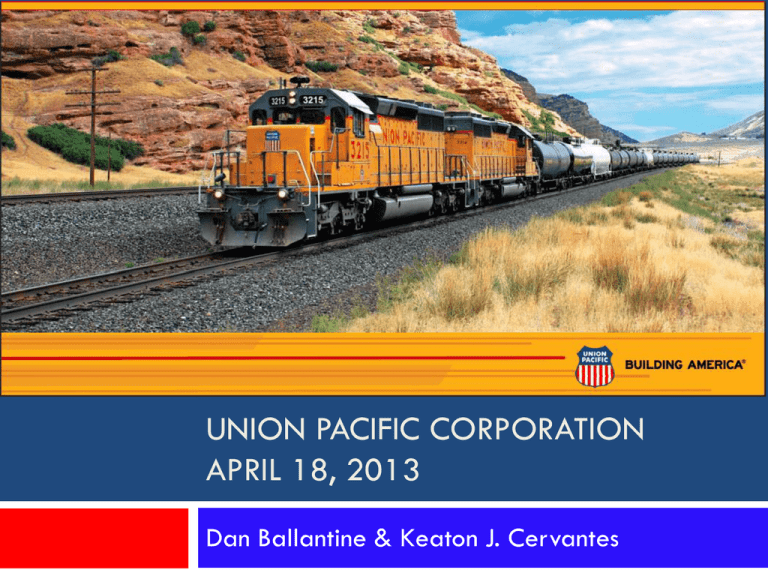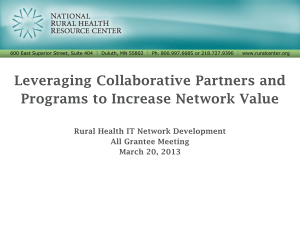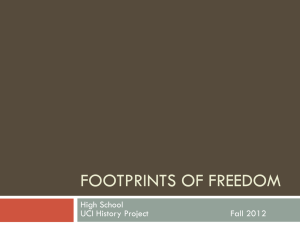UNP
advertisement

UNION PACIFIC CORPORATION APRIL 18, 2013 Dan Ballantine & Keaton J. Cervantes Agenda Introduction Macroeconomic Outlook Industry Overview Company Overview Financial Analysis Valuation Recommendation Union Pacific Corporation Incorporated in 1862 Headquarters is located in Omaha, Nebraska 45,928 full-time employees (86% under union contract) Operates 31,868 miles of track Maintains a fleet of 8,391 locomotives Provides rail service to 23 states throughout the Midwest, Western United States, and Mexico Source: Union Pacific 2012 10-K Macroeconomic Outlook Continued decline in coal shipments Shale oil boom causes supply bottlenecks Push to modernize fleets End of drought brings increased agricultural shipments Increased production in Mexico Source: Wall Street Journal Macroeconomic Outlook Keystone XL Pipeline Intended to relieve the supply build-up in Midwest and Canada Proposed route crosses the Ogallala Aquifer Permit was denied on January 18, 2012 by President Obama Source: keystone-xl.com Macroeconomic Outlook Keystone XL Pipeline Permit was denied based on possible environment consequences Recent pipeline failure in Arkansas has reignited fears of environmental impact of pipeline Approval is uncertain at the moment Source: Wall Street Journal Macroeconomic Outlook US-Mexico Rail Trade Steadily increasing trade values in four major areas Mexico Automotive Production: Projected to increase 38% in the next three years due to higher labor costs in China Source: US DOT Federal Railroad Administration, Bloomberg Industry Forces Analysis Buyers: MEDIUM New Entrants: LOW Rivalry: MEDIUM Suppliers: HIGH Substitutes: HIGH Industry Forces Analysis Bargaining Power of Suppliers: HIGH Bargaining Power of Buyers: MEDIUM Some inputs with no pricing power (fuel) Low number of locomotive and rail suppliers Relatively few industry competitors High number of alternatives Threat of New Entrants: LOW Capital intensive business with high barriers to entry Geographic specificity Industry Forces Analysis Threat of Substitutes: HIGH Many alternatives to transporting goods including river barge, trucking, and pipeline Rivalry among Competitors: MEDIUM Limited companies in the industry Limited direct competition due to geographic differences of the main industry players Company Overview Source: Union Pacific Website Company Overview Freight Revenue (94%) Agricultural Automotive Chemicals Coal Industrial Products Intermodal 2012 Freight Revenue Other Revenue (6%) Source: Union Pacific 2012 10-K Company Overview Positives Revenue generated from chemical shipments (including oil) is up 20% in 2012 45% of revenue from Mexico is through automotive shipments As the drought weakens, agricultural shipments will steadily increase Increase in fuel costs partially offset by fuel surcharges Issues Year-over-year reduction in shipments of coal Company Overview Source: Union Pacific 2012 10-K Business Risk Analysis Fluctuating fuel costs Required to transport hazardous cargo Subject to government regulation Sensitive to general economic conditions Work stoppage due to unionized labor Vulnerable to political events SWOT Analysis Strengths Weaknesses - Excess cash reserves can - Largely unionized workforce allow UNP to upgrade fleet may lead to work stoppages - Rail lines provide access to - Aging locomotive fleet shale oil reserves - Strong operational efficiency Opportunities Threats - Continued growth in oil shipments - Upgrade fleet to be more fuel efficient - Increased trade between US and Mexico - Keystone XL approval - Economic downturn - Continual decline in coal shipments Strategy Invest in network of rail and locomotives by replacing existing equipment, in addition to compliance with Positive Train Control (PTC) Increase the use of fuel surcharges to reduce vulnerability to rising fuel costs More efficient locomotives Increased shareholder returns through additional dividend raises and share repurchases Source: Union Pacific 2012 10-K Management Outlook Concern over decreased coal volume in 2013 Concerns over agricultural volume in the first half of 2013 Long-term acceptance of the Keystone XL pipeline Additional investment in intermodal terminals Additional growth opportunities through trade with Mexico Target of sub-65% operating ratio by 2017 Source: Union Pacific Barclay’s Conference Recent News New CEO named in March 2012: Previous CEO took a medical leave due to cancer 2012 marked Union Pacific’s 150th year of existence 4Q 2012: record quarter profits in addition to most profitable year in company’s history Record safety performance in 2012, despite a June 2012 collision of two Union Pacific trains in Goodwell, Oklahoma, killing three Source: Union Pacific Website News Releases Recent Financial Information Revenues ($ millions) $4,500 $4,000 $3,500 $3,000 $2,500 $2,000 $1,500 $1,000 $500 $2008 2009 2010 2011 2012 2011 2012 Net Income ($ millions) $4,500 $4,000 $3,500 $3,000 $2,500 $2,000 $1,500 $1,000 $500 $2008 2009 2010 Source: Union Pacific 2012 10-K, 2010 10-K Recent Financial Information Operating Ratio Source: Union Pacific 3/5/13 Raymond James Presentation Current Stock Information Metric Current Stock Price Trailing P/E Forward P/E Dividend Yield Market Cap ($ millions) Value $136.94 16.56 14.58 2.02% $64,142.7 Source: Capital IQ, Yahoo Finance Financial Analysis Current Ratio Quick Ratio Cash Ratio Operating Profit Margin Net Margin ROA ROE (Book Value) Debt/Assets Debt/Equity Interest Coverage Liquidity Ratios 2008 2009 0.98 1.37 0.36 0.43 0.43 0.69 2010 1.16 0.58 0.37 2011 1.12 0.61 0.37 2012 1.16 0.64 0.34 Profitability Ratios 2008 2009 22.68% 23.98% 13.01% 13.42% 6.01% 4.62% 15.07% 11.72% 2010 29.36% 16.39% 6.50% 16.02% 2011 29.27% 16.83% 7.47% 18.12% 2012 32.23% 18.84% 8.55% 20.51% Solvency Ratios 2008 2009 0.22 0.23 0.58 0.58 7.97 5.65 2010 0.21 0.52 8.27 2011 0.20 0.48 10.01 2012 0.19 0.45 12.61 Financial Analysis A/R Turnover Days Sales Outstanding Fixed Asset Turnover Total Asset Turnover Activity Ratios 2008 2009 29.31 22.45 12.45 16.26 0.51 0.39 0.46 0.34 2010 18.34 19.90 0.45 0.40 2011 15.13 24.12 0.50 0.44 2012 15.32 23.83 0.51 0.45 Tax Burden Interest Burden Operating Profit Margin Asset Turnover Leverage ROE DuPont Analysis 2008 2009 65.60% 67.98% 87.46% 82.31% 22.68% 23.98% 45.24% 33.35% 2.57 2.50 15.14% 11.20% 2010 63.48% 87.91% 29.36% 39.37% 2.43 15.65% 2011 63.90% 90.01% 29.27% 43.37% 2.43 17.72% 2012 63.49% 92.07% 32.23% 44.38% 2.37 19.84% Comparable Companies Revenue ($ millions) Market Cap ($ millions) Miles of Track Revenue/ Track Miles Canadian National Railway Company $9,788 $41,697 20,100 $486,970 Canadian Pacific Railway Limited $5,619 $21,644.6 14,400 $390,229 CSX Corp. $11,756 $25,038 21,000 $559,809 Kansas City Southern $2,239 $11,876 6,300 $355,333 Norfolk Southern Corp $11,040 $24,156 20,000 $552,000 Union Pacific Corporation $20,926 $66,170 31,868 $656,646 Company Source: Capital IQ Stock Performance Source: Yahoo Finance Comparable Company Analysis Target Company Union Pacific Corporation Ticker Symbol Price/Book Forward Forward (Exchange) Value TEV/Sales TEV/EBITDA Forward P/E UNP (NYSE) 3.40x 3.36x 8.00x 15.04 Comparable Companies Canadian National Railway Company Canadian Pacific Railway Limited CSX Corp. Kansas City Southern Norfolk Southern Corp. CNR (TSX) CP (TSX) CSX (NYSE) KSU (NYSE) NSC (NYSE) Comparable Statistics High Median Low Mean 3.90x 4.40x 2.80x 3.90x 2.50x 4.61x 4.25x 2.81x 5.60x 2.85x 9.90x 11.40x 7.30x 13.90x 7.80x 16.22 20.35 13.69 26.10 13.82 4.40x 3.90x 2.50x 3.50x 5.60x 4.25x 2.81x 4.02x 13.90x 9.90x 7.30x 10.06x 26.10 16.22 13.69 18.04 Source: Capital IQ Comparable Company Analysis Multiple Price/Book Value Forward TEV/Sales Forward TEV/EBITDA Forward P/E Multiple Price/Book Value Forward TEV/Sales Forward TEV/EBITDA Forward P/E UNP Implied Stock Price Low $ $ $ $ 103.68 110.83 122.88 128.59 Implied UNP Share Price Median High $ 161.73 $ 182.47 $ 178.63 $ 242.19 $ 174.30 $ 253.40 $ 152.35 $ 245.16 Weight 30% 30% 15% 25% Mean $ $ $ $ Implied UNP Stock Price $ 145.15 $ 167.99 $ 177.46 $ 169.41 $ 162.91 Source: Capital IQ 145.15 167.99 177.46 169.41 Discount Rate CAPM Risk-Free Rate Market Risk Premium 5-Year Beta CAPM Cost of Equity 3.12% 6.00% 0.74 7.53% Annual Realized Returns Year 1 2 3 4 5 Actual 33.55% 13.93% 29.44% 66.00% -27.50% Total Realized Return 137.03% Arithmetic Annual Return Geometric Annual Return 23.08% 18.84% Discount Rate Weighted Average Cost of Capital Share Price $ 141.27 Shares Outstanding (millions) 468.40 Market Value of Equity $ 66,170.87 Debt 8,997.00 Percent Equity Weight Percent Debt Weight 88.03% 11.97% Cost of Debt Cost of Equity CAPM Cost of Equity UNP Realized Return Cost of Equity 5.95% Tax Rate WACC 7.53% 18.84% 12.05% 38.0% 11.05% 60.00% 40.00% Cost of Equity Weightings DCF Analysis Union Pacific Corporation Discounted Cash Flow Analysis ($ millions) Net Income Depreciation Capital Expenditures Changes in Net Working Capital Less Increases in A/R Less Increases in Inventories Plus Increases in A/P Free Cash Flow Present Value Discount Rate 2014E 5,483 1,836 (3,700) 2015E 6,149 1,924 (3,800) 2016E 7,057 2,014 (3,500) (101) (104) 418 3,153 2,839 (139) (103) 451 3,828 3,104 (138) (79) 481 4,537 3,312 (120) (70) 468 5,849 3,846 2017E Terminal Value 8,152 1,925 (2,300) (19) (93) 434 8,098 4,794 103,578 61,322 11.05% Calculation of Implied Share Price Implied Enterprise Value Less Debt Plus Cash Implied Market Cap Implied Share Price 2013E 4,671 1,869 (3,600) $ $ $ $ $ 79,218 (8,997) 1,063 71,284 152.19 Terminal Value Terminal Growth Rate 3.00% Decision Drivers Strengths Improved operating ratio and efficiency Short-term growth in oil transportation in addition to longer-term growth in Mexico Management’s plan to return cash to shareholders GICS Diversification Concerns Sensitivity to approval of Keystone XL pipeline Declining demand for coal Recommendation Valuation Summary Current Stock Price: $136.94 per share Comparable Companies Valuation: $162.91 per share DCF Valuation: $152.19 per share Recommendation: BUY Buy 100 shares at current market price 100 shares at current market price = $13,694 Questions?









